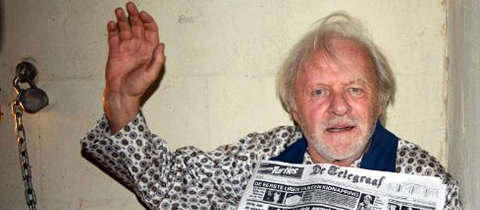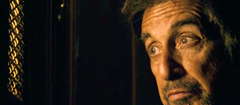(Originally published on blogcritics.org)
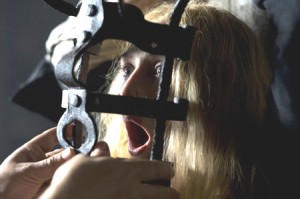
sorcery fare. This ScreamFest 2010 winner stars Sean Bean (The Lord of the Rings), Eddie Redmayne (Tony winner 2010 for Red), David Warner (Titanic), John Lynch (The Bridge of San Luis Rey) and Carice van Houten (Black Book).
Europe in 1348 lies victim to the Black Death. In a nice bit of visual irony, as the narrator, Wolfstan (Lynch), bemoans the fact that no one knows what causes the disease, we watch rats scamper over dead bodies.
Rumors of a village immune to the black death, perhaps led by a necromancer, inspire a bishop to investigate. He sends Ulric (Bean), a masterful knight, who leads a band of fighters, some pious and others less so. Ulric also seeks a spiritual guide for the group from a monastery and is provided the services of a young monk, Osmond (Redmayne).
The structure I’ve just described may remind Dungeons and Dragons fans of a typical game scenario. It resembles that, but this is no D&D movie. It captures the faith, dirt and blood of medieval life like no D&D film ever has. In spite of its Screamfest honors and “scary movie” marketing, it is, to its credit, painfully realistic and philosophical. (But don’t let that philosophical stuff keep you away).
Osmond is the hero. Torn from his normal life at the monastery, he is placed on the quest to find the necromancer. He also has an internal conflict; he has a childhood sweetheart, Averill (played by Kimberley Nixon). Can he love both God and Averill? His efforts to save Averill, first from the plague and then from the necromancer complicate his relationship with his fellow soldiers of God.
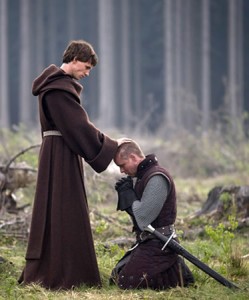
Ulric is both leader of the quest and Osmond’s mentor. In a quiet moment Osmond confides to Ulric, “God has punished me.” Ulric, with soldierly directness and the wisdom of age, counters, “God has better things to think of.”
The necromancer is the antagonist. The identity of the necromancer is a mystery Ulric and Osmond need to unravel, so I won’t mention it here.
The cinematography is beautiful and enhances the atmosphere of the film. Nearly every scene seems shot under an overcast sky and the film has been given a brownish, almost sepia, tint. Camera angles support the dramatic moments — as in the depiction of Ulric’s fate — without calling attention to themselves.
The dialog is excellent, with one exception. Everyone seems to fit into the period without being trite or affected, except the necromancer. The necromancer sounds like a recent graduate of Harvard with a double major in Sociology and Psychology.
With the exception of the necromancer’s dialog, writing, acting and directing are first class. In movies where you have a band of soldiers — or spelunkers, skateboarders, zombie hunters, whatever — going on a quest, it is sometimes hard to keep the supporting characters straight. Not so, here. The knights accompanying Ulric have unique personalities which are identified early
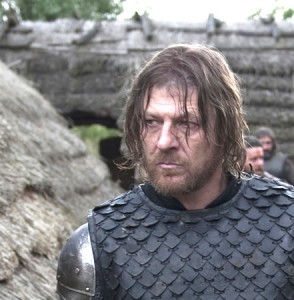
with more action than dialog. And they serve a purpose greater than targets for bad guy arrows, for instance, by shedding light on the death of innocents: “Sparing peoples suffering; sometimes that is all you can do.”
Black Death deserves high marks on almost everything. I had only one problem with it (and I bounced this observation off my daughter — a super film buff — and she had an identical reaction).
The film seems to have two endings. In the first ending, Osmund finds redemption as he is returned to the monastery. His love and Ulrich’s sacrifice have brought him through the trials. Then, almost to say, “Oh wait, we were only kidding”, this is followed by a heavily narrated “revenge” ending which seems tacked on and not foreshadowed. This ending says, “Life is pain and then you die.” Whew, that was close! It looked for a second like we almost had a film about faith and hope.
Both producer Jens Meurer and Director Chris Smith were quite upfront about their desire to bash “fundamentalist religion.” Meuer suggested we should see Donald Rumsfeld in the devout knights. Early in the film a character describes Ulric as “…more dangerous than the pestilence itself.”
However, I think the producer and director may have been undercut by the humanity brought to the characters by the excellent cast, especially Bean and Redmayne. Had Meurer and Smith succeeded, I would have hated the film. I didn’t. The arrogant, sophisticated and cynical necromancer is not the hero; the human struggle for goodness and perfection is.


